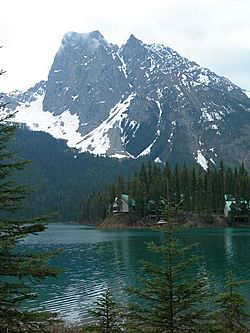Mount Burgess facts for kids
Quick facts for kids Mount Burgess |
|
|---|---|

Mount Burgess background and Emerald Lake foreground
|
|
| Highest point | |
| Elevation | 2,599 m (8,527 ft) |
| Prominence | 418 m (1,371 ft) |
| Parent peak | Mount Field (2642 m) |
| Listing | Mountains of British Columbia |
| Geography | |
| Parent range | Canadian Rockies |
| Topo map | NTS 82N/07 |
| Climbing | |
| First ascent | 1892 by James J. McArthur and H. Tuzo |
| Easiest route | Scramble |
Mount Burgess is a tall mountain in Yoho National Park, Canada. It stands at 2,599 m (8,527 ft) high. This mountain is part of the amazing Canadian Rockies mountain range.
You can find Mount Burgess near Burgess Pass. It is located between the Emerald River and Kicking Horse River Valleys.
Contents
History of Mount Burgess
How Mount Burgess Got Its Name
Mount Burgess was named in 1886. An astronomer named Otto Koltz gave it this name. He named it after Alexander MacKinnon Burgess. Mr. Burgess was a very important government official at the time. He was the Deputy Minister of the Interior. This meant he helped manage Canada's land and resources.
First Climbers Reach the Top
In 1892, a person named James J. McArthur was the first to climb Mount Burgess. He was working on a special project. He was mapping the lands close to the Canadian Pacific Railway.
The Amazing Burgess Shale Fossils
In 1909, a geologist named Charles Doolittle Walcott made an incredible discovery. A geologist is a scientist who studies rocks and the Earth. Walcott found a special place on Mount Burgess with many fossils. This place is called the Burgess Shale.
The Burgess Shale is a fossil bed. It's like a special treasure chest of ancient life. The fossils here are amazing because they show tiny details. They even show soft parts of animals that usually don't turn into fossils.
These fossils are about 508 million years old! They come from a time called the middle Cambrian period. Many of the creatures found here are unique. Some are so different that scientists still find them hard to classify.
Mount Burgess has two peaks. The lower peak to the north was named Walcott Peak. This was done to honor Charles D. Walcott for his important fossil discovery.
Mount Burgess on Money
Mount Burgess was so famous that it appeared on Canadian money! From 1954 to 1971, you could see Mount Burgess on the back of the Canadian ten-dollar bill.
A World Heritage Site
In 1984, a group called UNESCO recognized the area around Mount Burgess as very special. They declared it a World Heritage Site. This means it's a place of great importance to everyone in the world.



